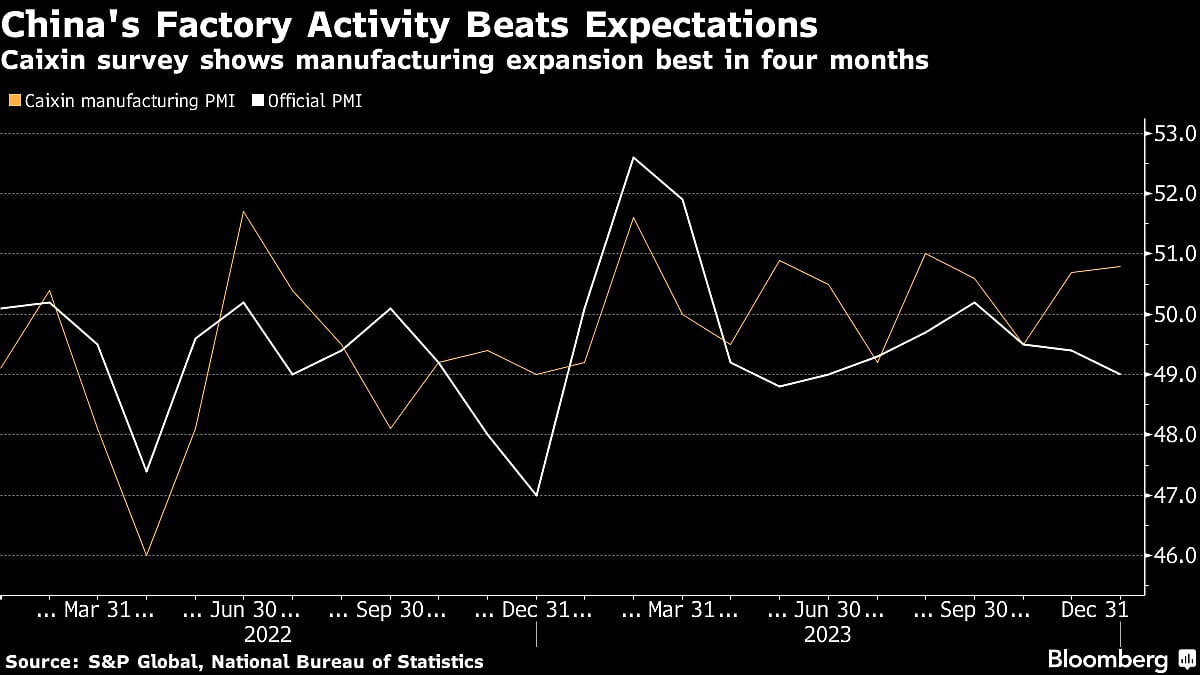China’s Factory Activity Picks Up, Private Survey Shows
The Caixin manufacturing purchasing managers index rose to 50.8 last month from 50.7 in November, the strongest reading since August.

(Bloomberg) -- A private gauge of China’s factory activity gained momentum in December, contrasting with official data that suggested the outlook for the nation’s manufacturers remains fragile.
The Caixin manufacturing purchasing managers index rose to 50.8 last month from 50.7 in November, the strongest reading since August and above the estimate in a Bloomberg survey of economists. A reading above 50 indicates expansion and anything below that points to contraction.
The release came after official data published over the weekend showed factory activity shrank in December to the lowest level in six months in a troubling sign for economic growth. The two surveys cover different sample sizes, geographic locations and types of businesses, which may explain some of the disparities.

“I think that still shows the manufacturing sector is on a fragile recovery,” said Michelle Lam, Greater China economist at Societe Generale SA. The better performance in the Caixin poll may suggest that small and medium sized businesses are doing “slightly better” than companies captured by the official survey, she added.
The beat in the Caixin survey wasn’t enough to boost markets. Chinese stocks extended losses on Tuesday, with the Hang Seng China Enterprises Index losing more than 1%. The onshore benchmark CSI 300 Index traded lower following a three-day winning streak. The offshore yuan was little changed at around 7.13 per dollar, while the yield on 10-year government bonds was steady at about 2.55%.
“The magnitude of the beat is smaller than the disappointment of the NBS PMI data,” said Marvin Chen, an analyst with Bloomberg Intelligence, referring to the survey published by the National Bureau of Statistics. “When taken together, it still points to an uncertain recovery.”
What Bloomberg Economics Says ...
“The index’s unexpected climb in December contrasts with the official PMI survey, which shows manufacturing contracting for a third straight month. The official survey aligns with high frequency indicators we track and likely gives a more accurate picture of conditions. We don’t think policymakers will be distracted by the Caixin; we see increasing odds that the central bank will cut its key rate as early as January.”
— Chang Shu and David Qu, economists
Read the full report here.
PMI surveys offer the earliest indication each month about the trajectory of the Chinese economy. The country’s recovery from the pandemic has been bumpy over the past year as the property crisis weighs on sentiment and confidence. Geopolitical strains also pose a challenge.
Chinese factories have been grappling with subdued demand and sluggish profits, official data has showed. Investment by manufacturers has held up, however, as Beijing has devoted financial resources and pushed favorable policies as it looks to support breakthroughs in advanced manufacturing and cutting-edge technology.
Manufacturers reported stronger increases in output and new orders last month, according to a statement released by Caixin and S&P Global on Tuesday accompanying the latest survey. Even so, business confidence for the year ahead was weak. Staffing levels fell for a fourth straight month, the survey showed, reflecting a cautious approach to hiring. Deflation pressure also lingered.
The Caixin survey results generally outperformed the official manufacturing PMI in 2023. Some economists have said the official poll may paint a more realistic picture of the economy, and the divergence could stem from relatively stronger performance of export-oriented firms.
Beijing ramped up stimulus in the final months of 2023 in a bid to secure an official growth target for the year of around 5%. Authorities are expected to set the goal for this year at a similar level. That may require more support from the government.
In his annual new year address, President Xi Jinping pledged to strengthen economic momentum and job creation. The speech also acknowledged some companies and citizens had endured a difficult 2023, a rare admission of domestic headwinds.
--With assistance from Wenjin Lv and Zhu Lin.
(Adds additional context and economists’ reaction.)
More stories like this are available on bloomberg.com
©2024 Bloomberg L.P.